boot JAGUAR XJ6 1997 2.G Owner's Manual
[x] Cancel search | Manufacturer: JAGUAR, Model Year: 1997, Model line: XJ6, Model: JAGUAR XJ6 1997 2.GPages: 227, PDF Size: 7.2 MB
Page 141 of 227
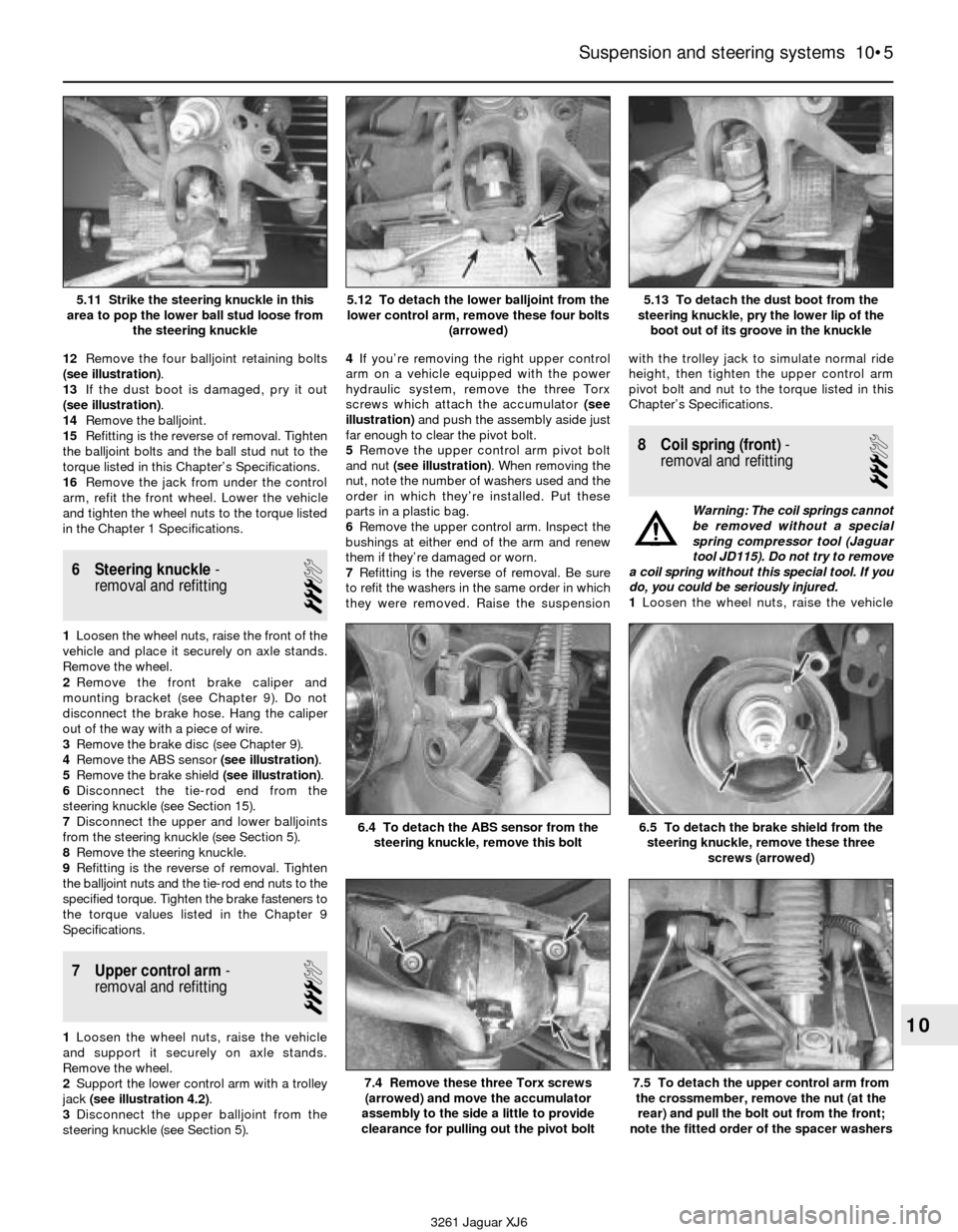
12Remove the four balljoint retaining bolts
(see illustration).
13If the dust boot is damaged, pry it out
(see illustration).
14Remove the balljoint.
15Refitting is the reverse of removal. Tighten
the balljoint bolts and the ball stud nut to the
torque listed in this Chapter’s Specifications.
16Remove the jack from under the control
arm, refit the front wheel. Lower the vehicle
and tighten the wheel nuts to the torque listed
in the Chapter 1 Specifications.
6 Steering knuckle-
removal and refitting
3
1Loosen the wheel nuts, raise the front of the
vehicle and place it securely on axle stands.
Remove the wheel.
2Remove the front brake caliper and
mounting bracket (see Chapter 9). Do not
disconnect the brake hose. Hang the caliper
out of the way with a piece of wire.
3Remove the brake disc (see Chapter 9).
4Remove the ABS sensor (see illustration).
5Remove the brake shield (see illustration).
6Disconnect the tie-rod end from the
steering knuckle (see Section 15).
7Disconnect the upper and lower balljoints
from the steering knuckle (see Section 5).
8Remove the steering knuckle.
9Refitting is the reverse of removal. Tighten
the balljoint nuts and the tie-rod end nuts to the
specified torque. Tighten the brake fasteners to
the torque values listed in the Chapter 9
Specifications.
7 Upper control arm-
removal and refitting
3
1Loosen the wheel nuts, raise the vehicle
and support it securely on axle stands.
Remove the wheel.
2Support the lower control arm with a trolley
jack (see illustration 4.2).
3Disconnect the upper balljoint from the
steering knuckle (see Section 5).4If you’re removing the right upper control
arm on a vehicle equipped with the power
hydraulic system, remove the three Torx
screws which attach the accumulator (see
illustration)and push the assembly aside just
far enough to clear the pivot bolt.
5Remove the upper control arm pivot bolt
and nut (see illustration). When removing the
nut, note the number of washers used and the
order in which they’re installed. Put these
parts in a plastic bag.
6Remove the upper control arm. Inspect the
bushings at either end of the arm and renew
them if they’re damaged or worn.
7Refitting is the reverse of removal. Be sure
to refit the washers in the same order in which
they were removed. Raise the suspensionwith the trolley jack to simulate normal ride
height, then tighten the upper control arm
pivot bolt and nut to the torque listed in this
Chapter’s Specifications.
8 Coil spring (front)-
removal and refitting
3
Warning: The coil springs cannot
be removed without a special
spring compressor tool (Jaguar
tool JD115). Do not try to remove
a coil spring without this special tool. If you
do, you could be seriously injured.
1Loosen the wheel nuts, raise the vehicle
Suspension and steering systems 10•5
10
5.11 Strike the steering knuckle in this
area to pop the lower ball stud loose from
the steering knuckle5.12 To detach the lower balljoint from the
lower control arm, remove these four bolts
(arrowed)5.13 To detach the dust boot from the
steering knuckle, pry the lower lip of the
boot out of its groove in the knuckle
6.5 To detach the brake shield from the
steering knuckle, remove these three
screws (arrowed)6.4 To detach the ABS sensor from the
steering knuckle, remove this bolt
7.4 Remove these three Torx screws
(arrowed) and move the accumulator
assembly to the side a little to provide
clearance for pulling out the pivot bolt7.5 To detach the upper control arm from
the crossmember, remove the nut (at the
rear) and pull the bolt out from the front;
note the fitted order of the spacer washers
3261 Jaguar XJ6
Page 144 of 227
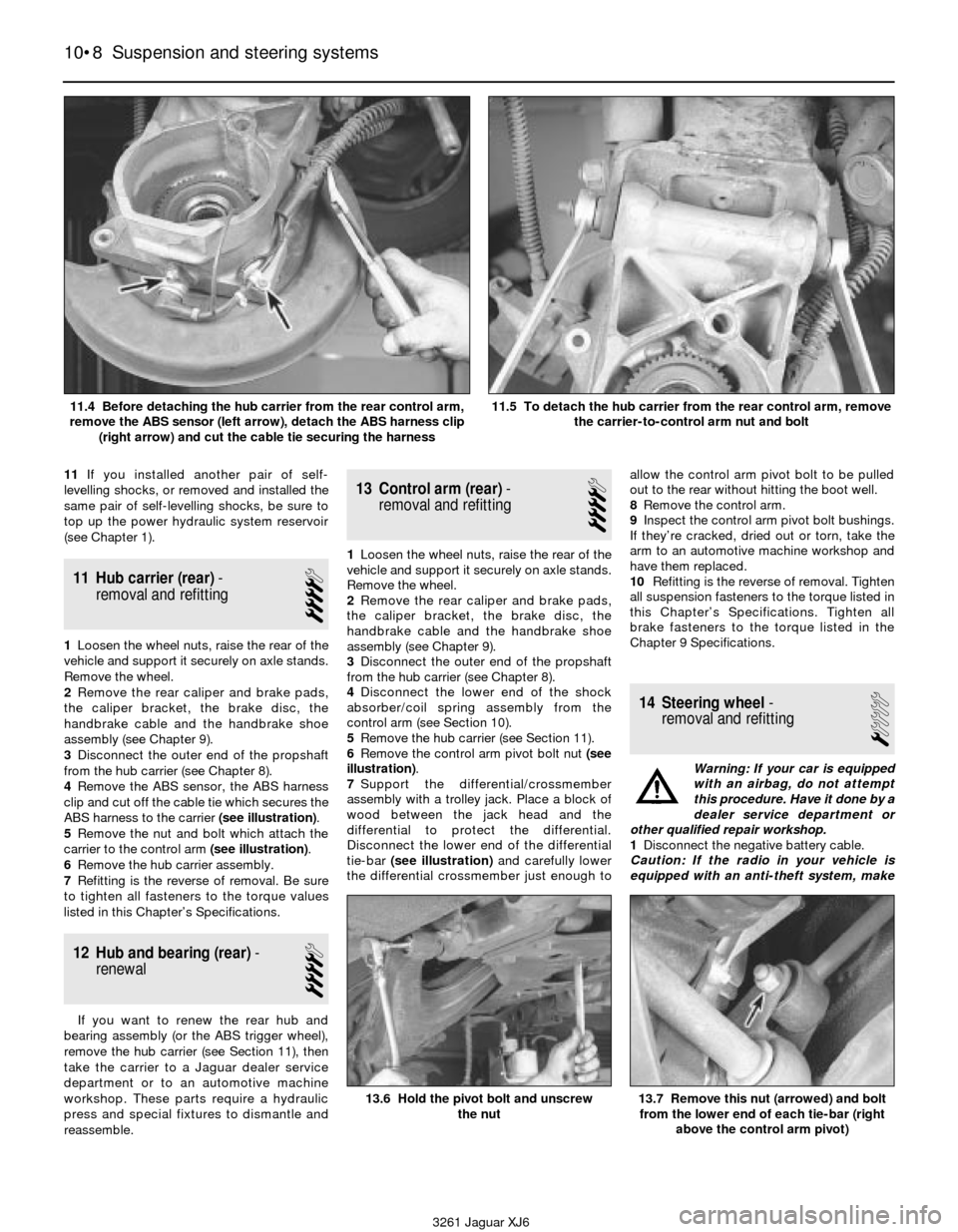
11If you installed another pair of self-
levelling shocks, or removed and installed the
same pair of self-levelling shocks, be sure to
top up the power hydraulic system reservoir
(see Chapter 1).
11 Hub carrier (rear)-
removal and refitting
4
1Loosen the wheel nuts, raise the rear of the
vehicle and support it securely on axle stands.
Remove the wheel.
2Remove the rear caliper and brake pads,
the caliper bracket, the brake disc, the
handbrake cable and the handbrake shoe
assembly (see Chapter 9).
3Disconnect the outer end of the propshaft
from the hub carrier (see Chapter 8).
4Remove the ABS sensor, the ABS harness
clip and cut off the cable tie which secures the
ABS harness to the carrier (see illustration).
5Remove the nut and bolt which attach the
carrier to the control arm (see illustration).
6Remove the hub carrier assembly.
7Refitting is the reverse of removal. Be sure
to tighten all fasteners to the torque values
listed in this Chapter’s Specifications.
12 Hub and bearing (rear)-
renewal
4
If you want to renew the rear hub and
bearing assembly (or the ABS trigger wheel),
remove the hub carrier (see Section 11), then
take the carrier to a Jaguar dealer service
department or to an automotive machine
workshop. These parts require a hydraulic
press and special fixtures to dismantle and
reassemble.
13 Control arm (rear)-
removal and refitting
4
1Loosen the wheel nuts, raise the rear of the
vehicle and support it securely on axle stands.
Remove the wheel.
2Remove the rear caliper and brake pads,
the caliper bracket, the brake disc, the
handbrake cable and the handbrake shoe
assembly (see Chapter 9).
3Disconnect the outer end of the propshaft
from the hub carrier (see Chapter 8).
4Disconnect the lower end of the shock
absorber/coil spring assembly from the
control arm (see Section 10).
5Remove the hub carrier (see Section 11).
6Remove the control arm pivot bolt nut (see
illustration).
7Support the differential/crossmember
assembly with a trolley jack. Place a block of
wood between the jack head and the
differential to protect the differential.
Disconnect the lower end of the differential
tie-bar (see illustration)and carefully lower
the differential crossmember just enough toallow the control arm pivot bolt to be pulled
out to the rear without hitting the boot well.
8Remove the control arm.
9Inspect the control arm pivot bolt bushings.
If they’re cracked, dried out or torn, take the
arm to an automotive machine workshop and
have them replaced.
10Refitting is the reverse of removal. Tighten
all suspension fasteners to the torque listed in
this Chapter’s Specifications. Tighten all
brake fasteners to the torque listed in the
Chapter 9 Specifications.
14 Steering wheel-
removal and refitting
1
Warning: If your car is equipped
with an airbag, do not attempt
this procedure. Have it done by a
dealer service department or
other qualified repair workshop.
1Disconnect the negative battery cable.
Caution: If the radio in your vehicle is
equipped with an anti-theft system, make
10•8 Suspension and steering systems
13.6 Hold the pivot bolt and unscrew
the nut13.7 Remove this nut (arrowed) and bolt
from the lower end of each tie-bar (right
above the control arm pivot)
3261 Jaguar XJ6 11.4 Before detaching the hub carrier from the rear control arm,
remove the ABS sensor (left arrow), detach the ABS harness clip
(right arrow) and cut the cable tie securing the harness
11.5 To detach the hub carrier from the rear control arm, remove
the carrier-to-control arm nut and bolt
Page 145 of 227

sure you have the correct activation code
before disconnecting the battery.
2Pry off the centre pad (see illustration).
3Remove the steering wheel nut and mark
the relationship of the steering wheel hub to
the shaft (see illustration).
4Slide the steering wheel off the steering
shaft (see illustration).
5Refitting is the reverse of removal. Make
sure you align the match marks you made on
the steering wheel and the shaft. Tighten the
steering wheel nut to the torque listed in this
Chapter’s Specifications.
15 Tie-rod ends-
removal and refitting
2
1Loosen the wheel nuts, raise the front of the
vehicle and support it securely on axle stands.
Remove the front wheel.
2Back off the locknut that locks the tie-rod
end to the tie-rod, then paint an alignment
mark on the threads to ensure the new tie-rod
end is installed in the same position (see
illustration).
3Loosen the nut on the tie-rod ball stud, then
fit a small puller and pop the ball stud loose
(see illustration). Remove the nut and
separate the ball stud from the steering
knuckle. Unscrew the tie-rod end from the tie-
rod.
4Refitting is the reverse of removal. Make
sure you thread the tie-rod end all the way up
to the mark on the threads, but no further.
Tighten the ball stud nut to the torque listed in
this Chapter’s Specifications. Tighten the
locknut securely.
5Have the toe-in checked and, if necessary,
adjusted at a dealer service department or
alignment workshop.
16 Steering gear boots- renewal
2
1Remove the tie-rod ends (see Section 15).
2Cut the boot clamps at both ends of the old
boots (see illustration)and slide off the
boots.3While the boots are removed, inspect the
seals in the end of the steering gear. If they’re
leaking, have them replaced by a dealer
service department or other qualified repair
workshop, or replace the steering gear with a
new or rebuilt unit (see Section 17).
4Slide the new boots into place and refit new
boot clamps.
5Refit the tie-rod ends (see Section 15).
Suspension and steering systems 10•9
10
14.4 To remove the steering wheel,
simply pull it straight off15.2 Back off this locknut and mark the
threads to ensure that the new tie-rod end
is installed properly
15.3 Loosen the ball stud nut, fit a small
puller and pop the ball stud loose from the
steering knuckle
3261 Jaguar XJ6 14.2 To remove the centre pad from the steering wheel,
simply pry it off
14.3 After removing the steering wheel nut, make a pair of
alignment marks on the steering wheel and steering shaft to
ensure proper reassembly
16.2 Cut off the boot clamps (arrowed)
and slide the boot off the steering gear
Page 146 of 227

17 Steering gear-
removal and refitting
3
Warning: On models with an
airbag, do not apply excessive
force or severe shock to the
steering column shaft, or
accidental deployment of the airbag could
occur.
1Using a large syringe or hand pump, empty
the power steering fluid reservoir.
2Loosen the wheel nuts, raise the vehicle
and support it securely on axle stands.
Remove the wheels.
3Mark the relationship of the steering shaft
U-joint to the steering gear pinion shaft (see
illustration)to ensure proper alignment when
they’re reassembled. Remove the nut and bolt
that clamp the U-joint to the pinion shaft.
4Disconnect the power steering pressure
and return lines from the steering gear. Place
a container under the lines to catch spilledfluid. Plug the lines to prevent excessive fluid
loss and contamination. Discard the sealing
washers (new ones should be used when
reassembling).
5Disconnect the tie-rod ends from the
steering knuckle arms (see Section 17).
6Remove the nuts and bolts from the steering
gear mounting brackets (see illustration).
7Remove the steering gear assembly,
detaching the U-joint as you lower it. Don’t
damage the steering gear dust boots.
8Refitting is the reverse of removal. Ensure the
marks you made on the U-joint and the pinion
shaft are aligned before you tighten the U-joint
clamp bolt and nut. Tighten the mounting bolts,
the tie-rod end nuts and the U-joint shaft
clamping bolts to the specified torque.
9After lowering the vehicle, fill the reservoir
with the recommended fluid (see Chapter 1).
10Bleed the power steering system (see
Section 19).
11Have the front wheels aligned by a dealer
service department or alignment workshop
after reassembly.
18 Power steering pump-
removal and refitting
3
1Raise the vehicle and support it securely on
axle stands. Remove the engine under-cover.
2Loosen the hose clamp and disconnect the
fluid return hose from the top of the pump
(see illustration)and drain the power steering
fluid from the reservoir into a clean container.
Unscrew the pressure line fitting from the
back of the pump. Plug the return hose and
the pressure line to prevent fluid from leaking
and to protect the power steering system
from contamination.
3Remove the bolts (see illustration)that
attach the power steering pump adapter to
the auxiliary shaft housing.
4Remove the power steering pump and
adapter.
5Take the power steering pump and adapter
to a Jaguar dealer service department and
have the adapter removed from the old pump
10•10 Suspension and steering systems
18.2 Disconnect the steering fluid return hose from the upper
pipe (arrowed) and disconnect the pressure line
from the back of the pump18.3 To detach the pump adapter from the auxiliary shaft
housing, remove these bolts
3261 Jaguar XJ6 17.3 Mark the relationship of the steering shaft U-joint to the
steering gear pinion shaft, then unscrew the pressure and return
line fittings (arrowed) - plug the lines to prevent contamination
from entering the system
17.6 To detach the steering gear from the vehicle, remove these
nuts and bolts (arrowed) from the mounting brackets (right
bracket shown, left bracket similar)
Page 149 of 227
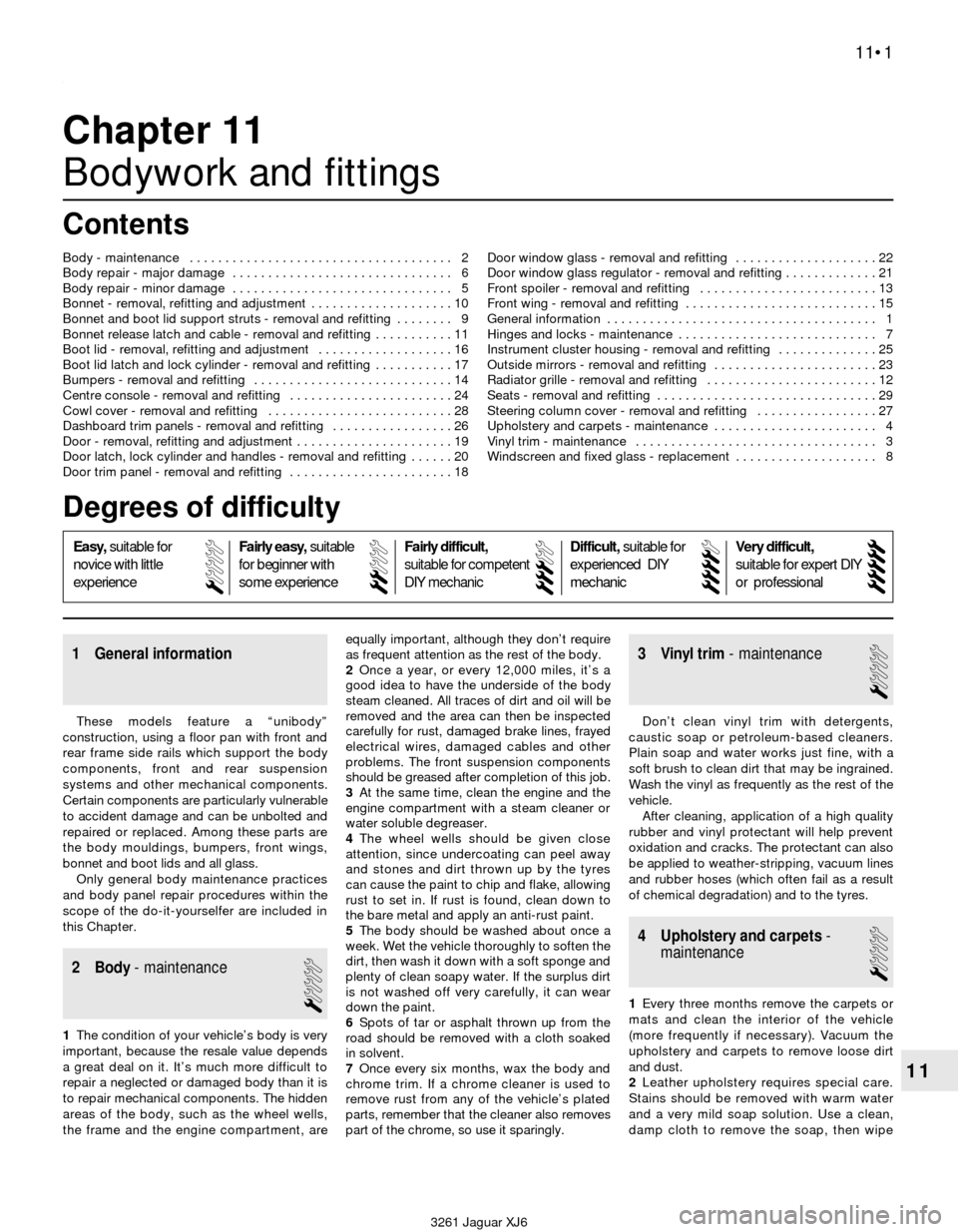
3261 Jaguar XJ6
11
Chapter 11
Bodywork and fittings
Body - maintenance . . . . . . . . . . . . . . . . . . . . . . . . . . . . . . . . . . . . . 2
Body repair - major damage . . . . . . . . . . . . . . . . . . . . . . . . . . . . . . . 6
Body repair - minor damage . . . . . . . . . . . . . . . . . . . . . . . . . . . . . . . 5
Bonnet - removal, refitting and adjustment . . . . . . . . . . . . . . . . . . . . 10
Bonnet and boot lid support struts - removal and refitting . . . . . . . . 9
Bonnet release latch and cable - removal and refitting . . . . . . . . . . . 11
Boot lid - removal, refitting and adjustment . . . . . . . . . . . . . . . . . . . 16
Boot lid latch and lock cylinder - removal and refitting . . . . . . . . . . . 17
Bumpers - removal and refitting . . . . . . . . . . . . . . . . . . . . . . . . . . . . 14
Centre console - removal and refitting . . . . . . . . . . . . . . . . . . . . . . . 24
Cowl cover - removal and refitting . . . . . . . . . . . . . . . . . . . . . . . . . . 28
Dashboard trim panels - removal and refitting . . . . . . . . . . . . . . . . . 26
Door - removal, refitting and adjustment . . . . . . . . . . . . . . . . . . . . . . 19
Door latch, lock cylinder and handles - removal and refitting . . . . . . 20
Door trim panel - removal and refitting . . . . . . . . . . . . . . . . . . . . . . . 18Door window glass - removal and refitting . . . . . . . . . . . . . . . . . . . . 22
Door window glass regulator - removal and refitting . . . . . . . . . . . . . 21
Front spoiler - removal and refitting . . . . . . . . . . . . . . . . . . . . . . . . . 13
Front wing - removal and refitting . . . . . . . . . . . . . . . . . . . . . . . . . . . 15
General information . . . . . . . . . . . . . . . . . . . . . . . . . . . . . . . . . . . . . . 1
Hinges and locks - maintenance . . . . . . . . . . . . . . . . . . . . . . . . . . . . 7
Instrument cluster housing - removal and refitting . . . . . . . . . . . . . . 25
Outside mirrors - removal and refitting . . . . . . . . . . . . . . . . . . . . . . . 23
Radiator grille - removal and refitting . . . . . . . . . . . . . . . . . . . . . . . . 12
Seats - removal and refitting . . . . . . . . . . . . . . . . . . . . . . . . . . . . . . . 29
Steering column cover - removal and refitting . . . . . . . . . . . . . . . . . 27
Upholstery and carpets - maintenance . . . . . . . . . . . . . . . . . . . . . . . 4
Vinyl trim - maintenance . . . . . . . . . . . . . . . . . . . . . . . . . . . . . . . . . . 3
Windscreen and fixed glass - replacement . . . . . . . . . . . . . . . . . . . . 8
11•1
Contents
Easy,suitable for
novice with little
experienceFairly easy,suitable
for beginner with
some experienceFairly difficult,
suitable for competent
DIY mechanic
Difficult,suitable for
experienced DIY
mechanicVery difficult,
suitable for expert DIY
or professional
Degrees of difficulty
54321
1 General information
These models feature a “unibody”
construction, using a floor pan with front and
rear frame side rails which support the body
components, front and rear suspension
systems and other mechanical components.
Certain components are particularly vulnerable
to accident damage and can be unbolted and
repaired or replaced. Among these parts are
the body mouldings, bumpers, front wings,
bonnet and boot lids and all glass.
Only general body maintenance practices
and body panel repair procedures within the
scope of the do-it-yourselfer are included in
this Chapter.
2 Body- maintenance
1
1The condition of your vehicle’s body is very
important, because the resale value depends
a great deal on it. It’s much more difficult to
repair a neglected or damaged body than it is
to repair mechanical components. The hidden
areas of the body, such as the wheel wells,
the frame and the engine compartment, areequally important, although they don’t require
as frequent attention as the rest of the body.
2Once a year, or every 12,000 miles, it’s a
good idea to have the underside of the body
steam cleaned. All traces of dirt and oil will be
removed and the area can then be inspected
carefully for rust, damaged brake lines, frayed
electrical wires, damaged cables and other
problems. The front suspension components
should be greased after completion of this job.
3At the same time, clean the engine and the
engine compartment with a steam cleaner or
water soluble degreaser.
4The wheel wells should be given close
attention, since undercoating can peel away
and stones and dirt thrown up by the tyres
can cause the paint to chip and flake, allowing
rust to set in. If rust is found, clean down to
the bare metal and apply an anti-rust paint.
5The body should be washed about once a
week. Wet the vehicle thoroughly to soften the
dirt, then wash it down with a soft sponge and
plenty of clean soapy water. If the surplus dirt
is not washed off very carefully, it can wear
down the paint.
6Spots of tar or asphalt thrown up from the
road should be removed with a cloth soaked
in solvent.
7Once every six months, wax the body and
chrome trim. If a chrome cleaner is used to
remove rust from any of the vehicle’s plated
parts, remember that the cleaner also removes
part of the chrome, so use it sparingly.
3 Vinyl trim- maintenance
1
Don’t clean vinyl trim with detergents,
caustic soap or petroleum-based cleaners.
Plain soap and water works just fine, with a
soft brush to clean dirt that may be ingrained.
Wash the vinyl as frequently as the rest of the
vehicle.
After cleaning, application of a high quality
rubber and vinyl protectant will help prevent
oxidation and cracks. The protectant can also
be applied to weather-stripping, vacuum lines
and rubber hoses (which often fail as a result
of chemical degradation) and to the tyres.
4 Upholstery and carpets-
maintenance
1
1Every three months remove the carpets or
mats and clean the interior of the vehicle
(more frequently if necessary). Vacuum the
upholstery and carpets to remove loose dirt
and dust.
2Leather upholstery requires special care.
Stains should be removed with warm water
and a very mild soap solution. Use a clean,
damp cloth to remove the soap, then wipe
Page 151 of 227
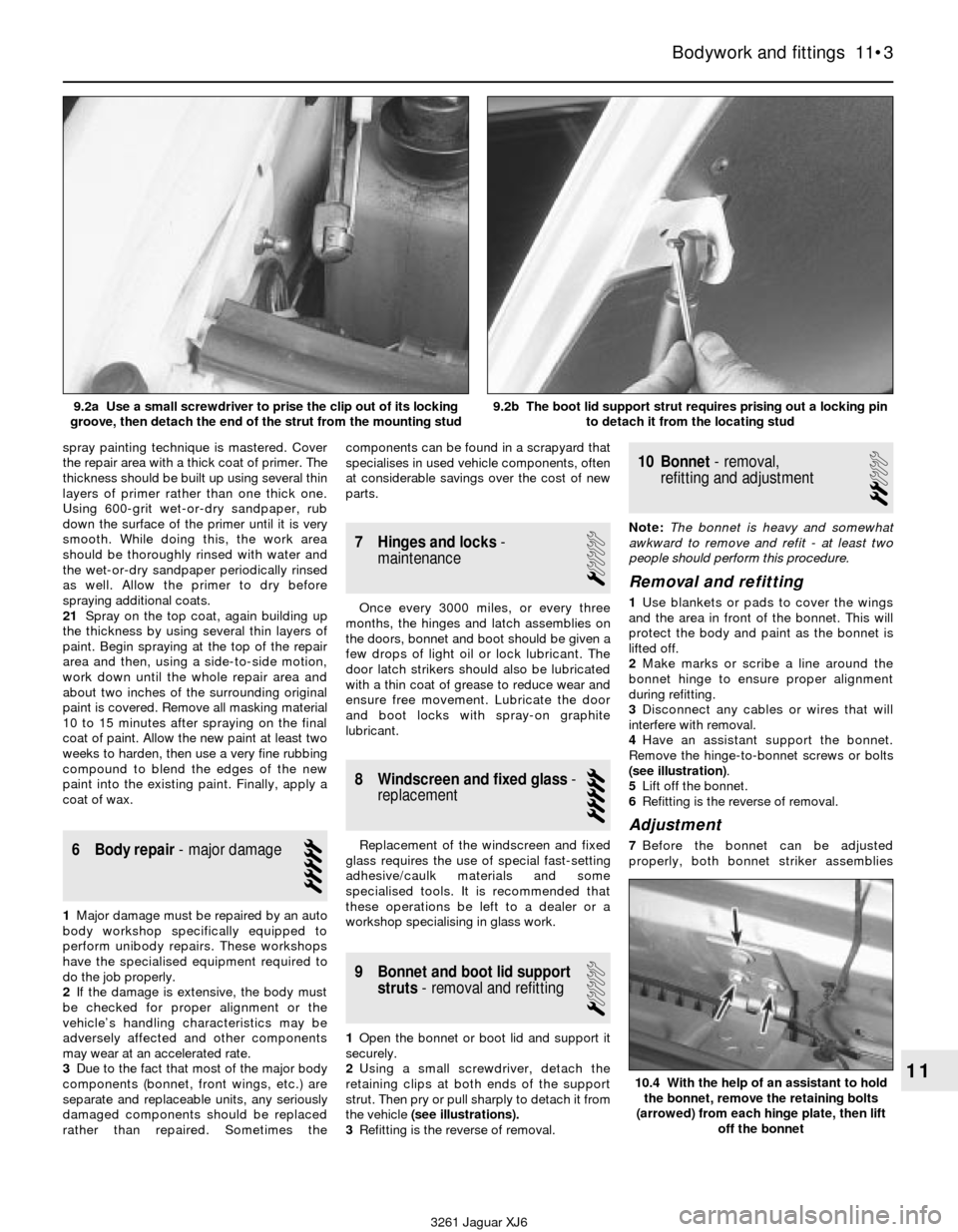
spray painting technique is mastered. Cover
the repair area with a thick coat of primer. The
thickness should be built up using several thin
layers of primer rather than one thick one.
Using 600-grit wet-or-dry sandpaper, rub
down the surface of the primer until it is very
smooth. While doing this, the work area
should be thoroughly rinsed with water and
the wet-or-dry sandpaper periodically rinsed
as well. Allow the primer to dry before
spraying additional coats.
21Spray on the top coat, again building up
the thickness by using several thin layers of
paint. Begin spraying at the top of the repair
area and then, using a side-to-side motion,
work down until the whole repair area and
about two inches of the surrounding original
paint is covered. Remove all masking material
10 to 15 minutes after spraying on the final
coat of paint. Allow the new paint at least two
weeks to harden, then use a very fine rubbing
compound to blend the edges of the new
paint into the existing paint. Finally, apply a
coat of wax.
6 Body repair- major damage
5
1Major damage must be repaired by an auto
body workshop specifically equipped to
perform unibody repairs. These workshops
have the specialised equipment required to
do the job properly.
2If the damage is extensive, the body must
be checked for proper alignment or the
vehicle’s handling characteristics may be
adversely affected and other components
may wear at an accelerated rate.
3Due to the fact that most of the major body
components (bonnet, front wings, etc.) are
separate and replaceable units, any seriously
damaged components should be replaced
rather than repaired. Sometimes thecomponents can be found in a scrapyard that
specialises in used vehicle components, often
at considerable savings over the cost of new
parts.
7 Hinges and locks-
maintenance
1
Once every 3000 miles, or every three
months, the hinges and latch assemblies on
the doors, bonnet and boot should be given a
few drops of light oil or lock lubricant. The
door latch strikers should also be lubricated
with a thin coat of grease to reduce wear and
ensure free movement. Lubricate the door
and boot locks with spray-on graphite
lubricant.
8 Windscreen and fixed glass-
replacement
5
Replacement of the windscreen and fixed
glass requires the use of special fast-setting
adhesive/caulk materials and some
specialised tools. It is recommended that
these operations be left to a dealer or a
workshop specialising in glass work.
9 Bonnet and boot lid support
struts- removal and refitting
1
1Open the bonnet or boot lid and support it
securely.
2Using a small screwdriver, detach the
retaining clips at both ends of the support
strut. Then pry or pull sharply to detach it from
the vehicle(see illustrations).
3Refitting is the reverse of removal.
10 Bonnet- removal,
refitting and adjustment
2
Note:The bonnet is heavy and somewhat
awkward to remove and refit - at least two
people should perform this procedure.
Removal and refitting
1Use blankets or pads to cover the wings
and the area in front of the bonnet. This will
protect the body and paint as the bonnet is
lifted off.
2Make marks or scribe a line around the
bonnet hinge to ensure proper alignment
during refitting.
3Disconnect any cables or wires that will
interfere with removal.
4Have an assistant support the bonnet.
Remove the hinge-to-bonnet screws or bolts
(see illustration).
5Lift off the bonnet.
6Refitting is the reverse of removal.
Adjustment
7Before the bonnet can be adjusted
properly, both bonnet striker assemblies
Bodywork and fittings 11•3
1110.4 With the help of an assistant to hold
the bonnet, remove the retaining bolts
(arrowed) from each hinge plate, then lift
off the bonnet
3261 Jaguar XJ69.2b The boot lid support strut requires prising out a locking pin
to detach it from the locating stud
9.2a Use a small screwdriver to prise the clip out of its locking
groove, then detach the end of the strut from the mounting stud
Page 154 of 227

3Remove two bumper retaining bolts located
on the bottom side of the bumper (see
illustration). Pull the bumper assembly out
and away from the vehicle to remove it.
4Refitting is the reverse of removal.
15 Front wing-
removal and refitting
3
1Loosen the front wheel nuts. Raise the
vehicle, support it securely on axle stands and
remove the front wheel.
2Remove the front bumper assembly (see
Section 14).
3Remove the front spoiler (see Section 13).4Detach the inner wing splash shield (see
illustration).
5On 1988 and 1989 models, remove the
coolant overflow reservoir located behind the
splash shield (see Chapter 3).
6On models with round headlights, remove
the headlight bezel. On models with
composite headlights (1992 Vanden Plas, all
1993 and later models), remove the headlight
(see Chapter 12).
7Remove the wing mounting bolts and nuts
(see illustrations).
8Detach the wing. It’s a good idea to have an
assistant support the wing while it’s being
moved away from the vehicle to prevent
damage to the surrounding body panels.
9Refitting is the reverse of removal.
16 Boot lid- removal,
refitting and adjustment
2
Note:The boot lid is heavy and somewhat
awkward to remove and refit - at least two
people should perform this procedure.
Removal and refitting
1Open the boot lid and cover the edges of
the boot compartment with pads or cloths to
protect the painted surfaces when the lid is
removed.
2Disconnect any cables or wire harness
connectors attached to the boot lid that would
interfere with removal.
3Make alignment marks around the hinge
mounting bolts with a marking pen.
4While an assistant supports the boot lid,
remove the lid-to-hinge bolts on both sides
and lift it off(see illustration).
5Refitting is the reverse of removal. Note:
When refitting the boot lid, align the lid-to-
hinge bolts with the marks made during
removal.
Adjustment
6Fore-and-aft and side-to-side adjustment
of the boot lid is done by moving the bonnet in
relation to the hinge plate after loosening the
bolts or nuts.
7Scribe a line around the entire hinge plate
as described earlier in this section so you can
judge the amount of movement.
11•6 Bodywork and fittings
14.3 Remove the two retaining bolts from
the bottom of the bumper, then remove the
bumper from the vehicle15.4 Remove the bolts (arrowed) securing
the inner wing splash shield15.7a Detach the wing retaining bolts
(arrowed) at the front of the wing
15.7c Working in the wheel opening,
remove the wing-to-rocker panel bolt
(arrowed)
15.7d Remove the wing-to-door pillar bolt
(arrow; lower bolt not visible)15.7e Detach the bolts along the
top of the wing
3261 Jaguar XJ6
15.7b Remove the wing-to-radiator
support bolt (arrowed)
16.4 With the help of an assistant to hold
the boot lid, remove the retaining bolts and
lift off the boot lid
Page 155 of 227
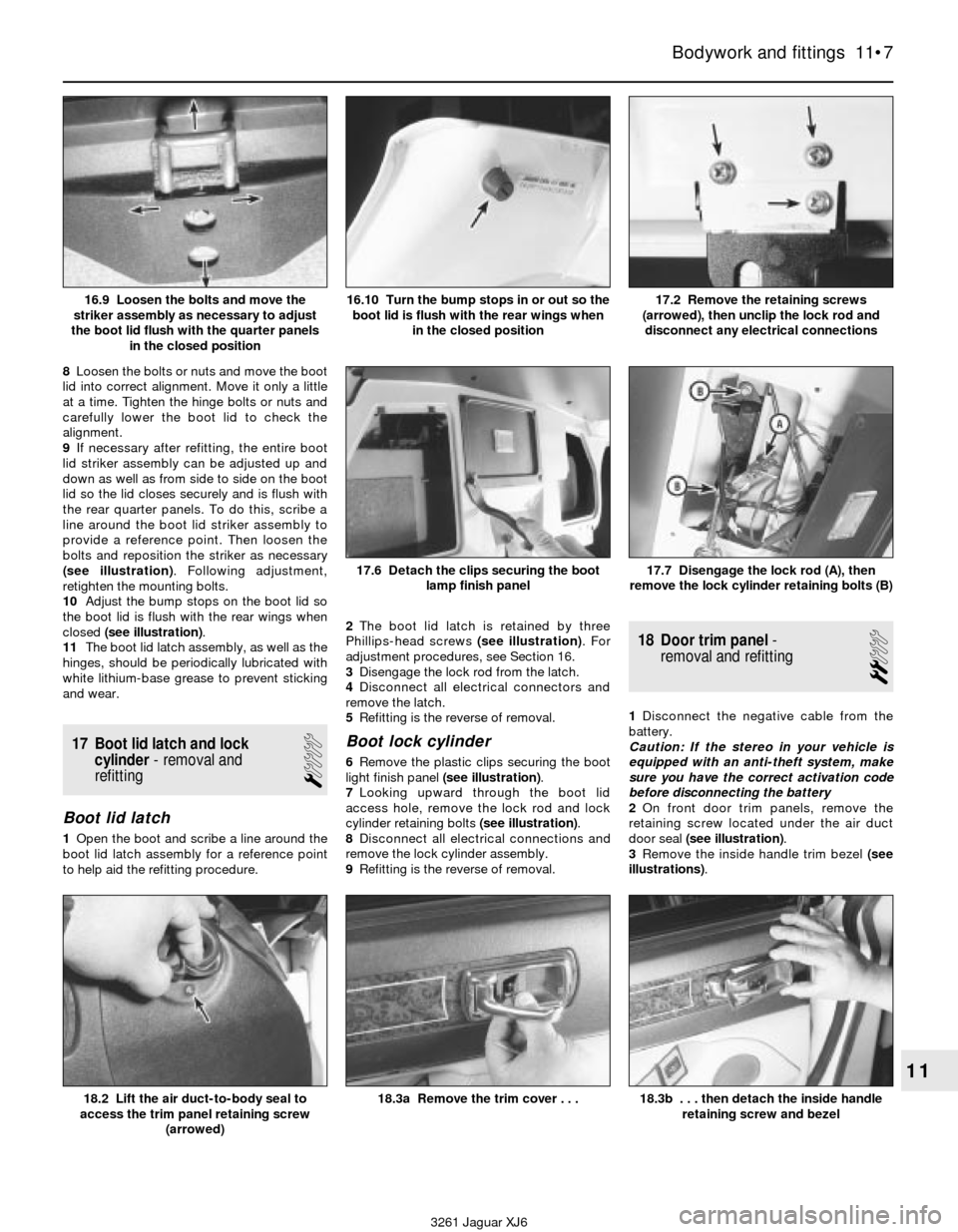
8Loosen the bolts or nuts and move the boot
lid into correct alignment. Move it only a little
at a time. Tighten the hinge bolts or nuts and
carefully lower the boot lid to check the
alignment.
9If necessary after refitting, the entire boot
lid striker assembly can be adjusted up and
down as well as from side to side on the boot
lid so the lid closes securely and is flush with
the rear quarter panels. To do this, scribe a
line around the boot lid striker assembly to
provide a reference point. Then loosen the
bolts and reposition the striker as necessary
(see illustration). Following adjustment,
retighten the mounting bolts.
10Adjust the bump stops on the boot lid so
the boot lid is flush with the rear wings when
closed (see illustration).
11The boot lid latch assembly, as well as the
hinges, should be periodically lubricated with
white lithium-base grease to prevent sticking
and wear.
17 Boot lid latch and lock
cylinder- removal and
refitting
1
Boot lid latch
1Open the boot and scribe a line around the
boot lid latch assembly for a reference point
to help aid the refitting procedure.2The boot lid latch is retained by three
Phillips-head screws (see illustration). For
adjustment procedures, see Section 16.
3Disengage the lock rod from the latch.
4Disconnect all electrical connectors and
remove the latch.
5Refitting is the reverse of removal.
Boot lock cylinder
6Remove the plastic clips securing the boot
light finish panel (see illustration).
7Looking upward through the boot lid
access hole, remove the lock rod and lock
cylinder retaining bolts (see illustration).
8Disconnect all electrical connections and
remove the lock cylinder assembly.
9Refitting is the reverse of removal.
18 Door trim panel-
removal and refitting
2
1Disconnect the negative cable from the
battery.
Caution: If the stereo in your vehicle is
equipped with an anti-theft system, make
sure you have the correct activation code
before disconnecting the battery
2On front door trim panels, remove the
retaining screw located under the air duct
door seal (see illustration).
3Remove the inside handle trim bezel (see
illustrations).
Bodywork and fittings 11•7
11
17.6 Detach the clips securing the boot
lamp finish panel17.7 Disengage the lock rod (A), then
remove the lock cylinder retaining bolts (B)
18.2 Lift the air duct-to-body seal to
access the trim panel retaining screw
(arrowed)18.3b . . . then detach the inside handle
retaining screw and bezel18.3a Remove the trim cover . . .
3261 Jaguar XJ6 16.9 Loosen the bolts and move the
striker assembly as necessary to adjust
the boot lid flush with the quarter panels
in the closed position
17.2 Remove the retaining screws
(arrowed), then unclip the lock rod and
disconnect any electrical connections16.10 Turn the bump stops in or out so the
boot lid is flush with the rear wings when
in the closed position
Page 170 of 227
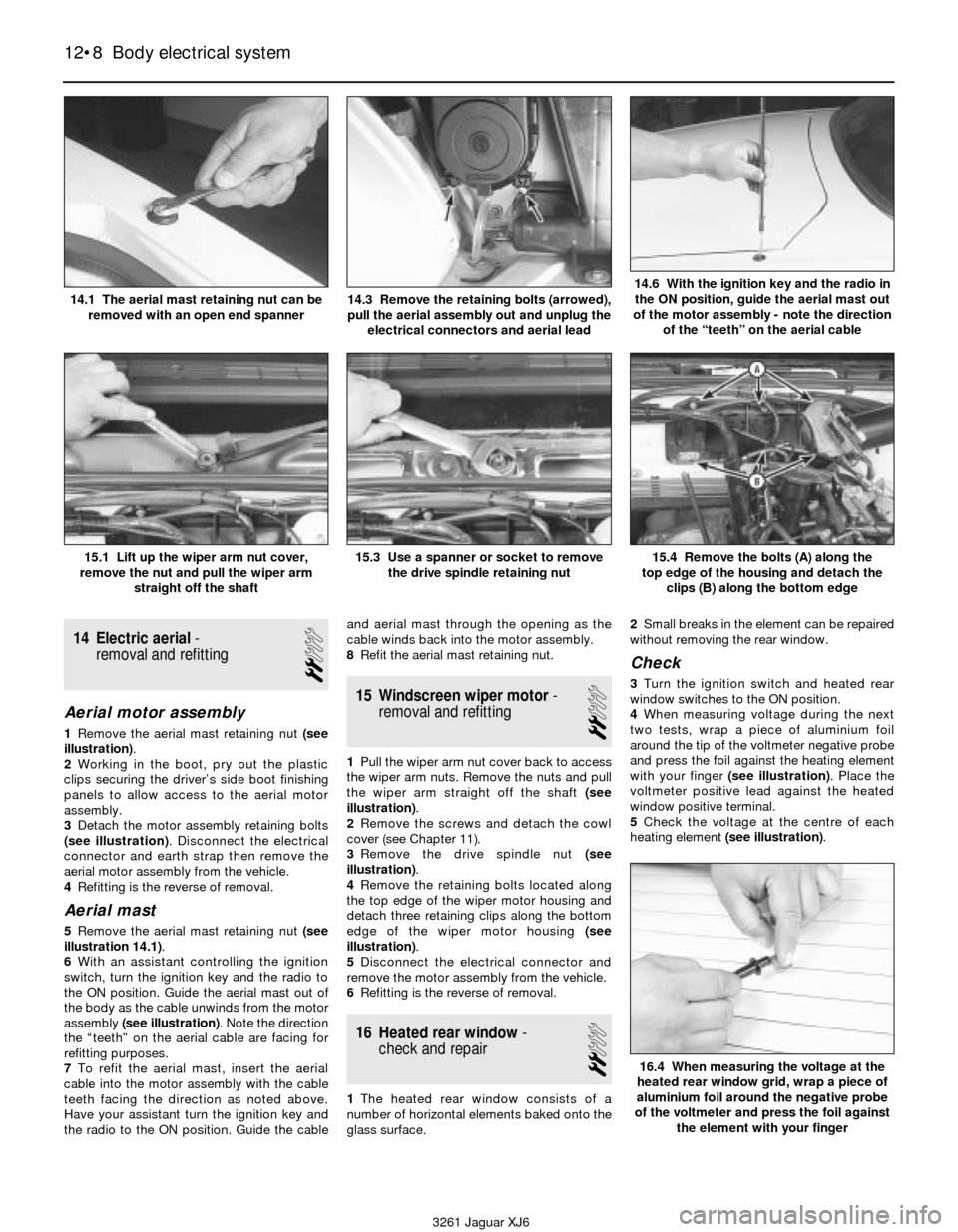
14 Electric aerial-
removal and refitting
2
Aerial motor assembly
1Remove the aerial mast retaining nut (see
illustration).
2Working in the boot, pry out the plastic
clips securing the driver’s side boot finishing
panels to allow access to the aerial motor
assembly.
3Detach the motor assembly retaining bolts
(see illustration). Disconnect the electrical
connector and earth strap then remove the
aerial motor assembly from the vehicle.
4Refitting is the reverse of removal.
Aerial mast
5Remove the aerial mast retaining nut (see
illustration 14.1).
6With an assistant controlling the ignition
switch, turn the ignition key and the radio to
the ON position. Guide the aerial mast out of
the body as the cable unwinds from the motor
assembly (see illustration). Note the direction
the “teeth” on the aerial cable are facing for
refitting purposes.
7To refit the aerial mast, insert the aerial
cable into the motor assembly with the cable
teeth facing the direction as noted above.
Have your assistant turn the ignition key and
the radio to the ON position. Guide the cableand aerial mast through the opening as the
cable winds back into the motor assembly.
8Refit the aerial mast retaining nut.
15 Windscreen wiper motor-
removal and refitting
2
1Pull the wiper arm nut cover back to access
the wiper arm nuts. Remove the nuts and pull
the wiper arm straight off the shaft (see
illustration).
2Remove the screws and detach the cowl
cover (see Chapter 11).
3Remove the drive spindle nut (see
illustration).
4Remove the retaining bolts located along
the top edge of the wiper motor housing and
detach three retaining clips along the bottom
edge of the wiper motor housing (see
illustration).
5Disconnect the electrical connector and
remove the motor assembly from the vehicle.
6Refitting is the reverse of removal.
16 Heated rear window-
check and repair
2
1The heated rear window consists of a
number of horizontal elements baked onto the
glass surface.2Small breaks in the element can be repaired
without removing the rear window.
Check
3Turn the ignition switch and heated rear
window switches to the ON position.
4When measuring voltage during the next
two tests, wrap a piece of aluminium foil
around the tip of the voltmeter negative probe
and press the foil against the heating element
with your finger (see illustration). Place the
voltmeter positive lead against the heated
window positive terminal.
5Check the voltage at the centre of each
heating element (see illustration).
12•8 Body electrical system
14.1 The aerial mast retaining nut can be
removed with an open end spanner14.3 Remove the retaining bolts (arrowed),
pull the aerial assembly out and unplug the
electrical connectors and aerial lead14.6 With the ignition key and the radio in
the ON position, guide the aerial mast out
of the motor assembly - note the direction
of the “teeth” on the aerial cable
15.1 Lift up the wiper arm nut cover,
remove the nut and pull the wiper arm
straight off the shaft15.3 Use a spanner or socket to remove
the drive spindle retaining nut15.4 Remove the bolts (A) along the
top edge of the housing and detach the
clips (B) along the bottom edge
3261 Jaguar XJ6
16.4 When measuring the voltage at the
heated rear window grid, wrap a piece of
aluminium foil around the negative probe
of the voltmeter and press the foil against
the element with your finger
Page 174 of 227
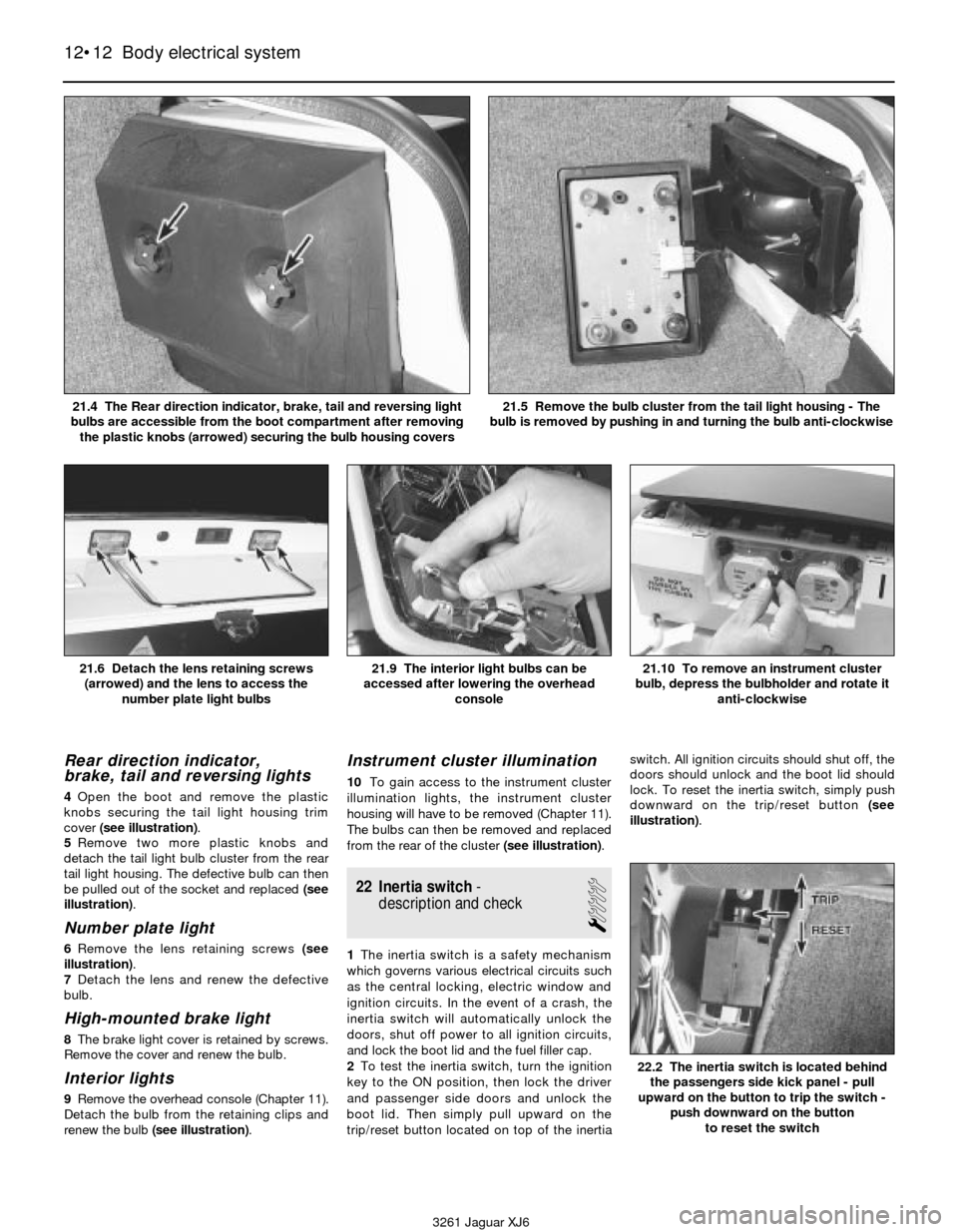
Rear direction indicator,
brake, tail and reversing lights
4Open the boot and remove the plastic
knobs securing the tail light housing trim
cover (see illustration).
5Remove two more plastic knobs and
detach the tail light bulb cluster from the rear
tail light housing. The defective bulb can then
be pulled out of the socket and replaced (see
illustration).
Number plate light
6Remove the lens retaining screws (see
illustration).
7Detach the lens and renew the defective
bulb.
High-mounted brake light
8The brake light cover is retained by screws.
Remove the cover and renew the bulb.
Interior lights
9Remove the overhead console (Chapter 11).
Detach the bulb from the retaining clips and
renew the bulb (see illustration).
Instrument cluster illumination
10To gain access to the instrument cluster
illumination lights, the instrument cluster
housing will have to be removed (Chapter 11).
The bulbs can then be removed and replaced
from the rear of the cluster (see illustration).
22 Inertia switch-
description and check
1
1The inertia switch is a safety mechanism
which governs various electrical circuits such
as the central locking, electric window and
ignition circuits. In the event of a crash, the
inertia switch will automatically unlock the
doors, shut off power to all ignition circuits,
and lock the boot lid and the fuel filler cap.
2To test the inertia switch, turn the ignition
key to the ON position, then lock the driver
and passenger side doors and unlock the
boot lid. Then simply pull upward on the
trip/reset button located on top of the inertiaswitch. All ignition circuits should shut off, the
doors should unlock and the boot lid should
lock. To reset the inertia switch, simply push
downward on the trip/reset button (see
illustration).
12•12 Body electrical system
21.6 Detach the lens retaining screws
(arrowed) and the lens to access the
number plate light bulbs21.9 The interior light bulbs can be
accessed after lowering the overhead
console21.10 To remove an instrument cluster
bulb, depress the bulbholder and rotate it
anti-clockwise
3261 Jaguar XJ6 21.4 The Rear direction indicator, brake, tail and reversing light
bulbs are accessible from the boot compartment after removing
the plastic knobs (arrowed) securing the bulb housing covers
21.5 Remove the bulb cluster from the tail light housing - The
bulb is removed by pushing in and turning the bulb anti-clockwise
22.2 The inertia switch is located behind
the passengers side kick panel - pull
upward on the button to trip the switch -
push downward on the button
to reset the switch